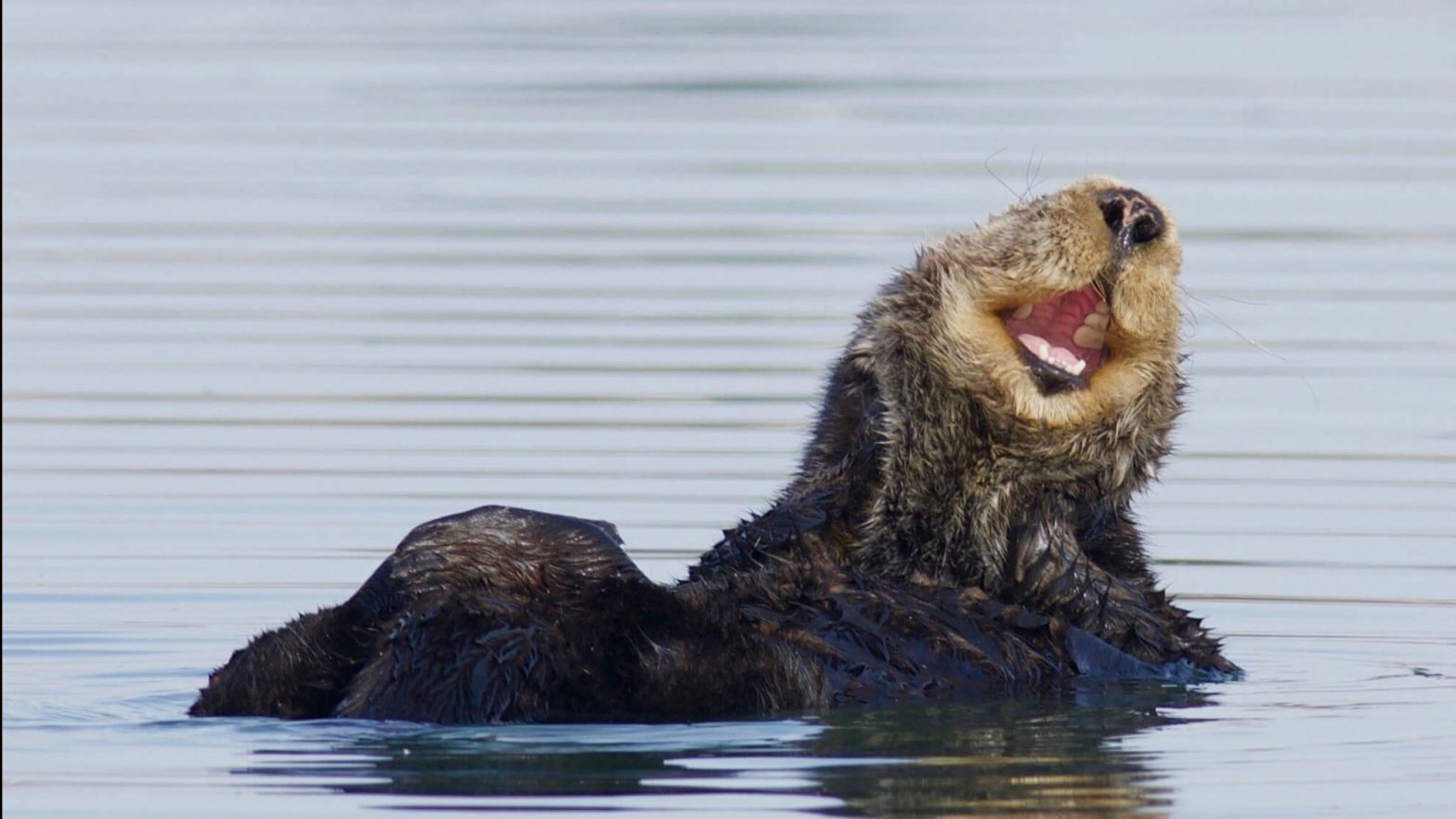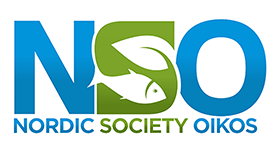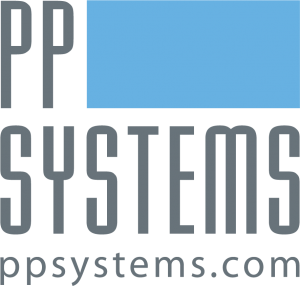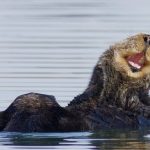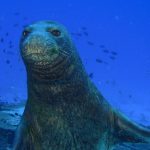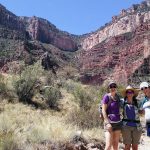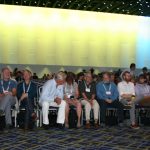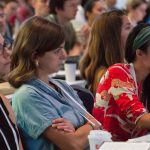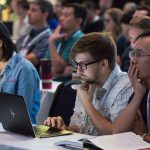Inspire 1
Interoperable Ecological Data – Putting the I into FAIR Data
Monday, August 2, 2021
8:30 AM-9:30 AM Pacific Time
Session Description
Publishing data for reuse by others and in new combinations to answer new questions is becoming more widespread in ecology. However, regardless of the latest buzzword or acronym describing the process, recommendations or requirements for data repositories, expectations of funders or journals, and advancing data archiving skills, the concept of data interoperability still remains elusive. It is interpreted differently by data providers, users, and repositories. Its multidimensionality makes it difficult to measure and communicate it, and, hence, manage expectations. This Inspire Session will provide a lively discussion of data interoperability as determined by sampling methodology, data storage technology, extent of data documentation and its semantics, and data aggregation and formatting decisions as well as skills required specifically for successful data integration to advance ecological knowledge.
One-sentence Summary
Although ecological research data are increasingly becoming publicly available, they generally are not ‘interoperable’ without major effort and deep understanding of the data. This session will explore solutions, approaches and specific skills to overcome some of the obstacles.
Organizer
Corinna Gries – University of Wisconsin, Center for Limnology
Co-organizer
Eric R. Sokol – Batelle, National Ecological Observatory Network (NEON)
Moderator
Corinna Gries – University of Wisonsin, Center for Limnology
Speakers
- Semantic annotations and data integration in ecology
- Anne E. Thessen, Oregon State University, Corvallis, OR, Mark Schildhauer, National Center for Ecological Analysis and Synthesis, University of California Santa Barbara, Santa Barbara, CA, Ramona L. Walls, CyVerse, University of Arizona, Tucson, AZ and Christopher Mungall, Lawrence Berkeley National Laboratory
- Beyond a collection of case studies: How interoperability can facilitate scientific generality in ecology
- Jessica Gurevitch, Stony Brook University
- Coding Club – Transferring quantitative skills among ecologists peer-to-peer
- Gergana Daskalova, University of Edinburgh and Isla H. Myers-Smith, Ecology, University of Edinburgh, Scotland
- Let’s be FAIR: A community-driven reporting format for field measurements of soil respiration
- Stephanie C. Pennington1, Ben Bond-Lamberty1, Danielle S. Christianson2, Robert Crystal-Ornelas2 and Kayla C. Mathes3, (1)Joint Global Change Research Institute, Pacific Northwest National Laboratory, (2)Earth and Environmental Sciences Area, Lawrence Berkeley National Lab, Berkeley, CA, (3)Department of Biology, Virginia Commonwealth University, Richmond, VA
- Matching metadata: A reporting format for leaf-level gas exchange data that enhances interoperability
- Kim S. Ely and Alistair Rogers, Environmental & Climate Sciences Department, Brookhaven National Laboratory, Upton, NY
- Going public – The path from academia to public-facing data portals
- Elizabeth Dobbins, College of Fisheries and Ocean Sciences, University of Alaska Fairbanks, Fairbanks, AK; Axiom Data Science, Fairbanks, AK
- Integrating data in Map of Life for Species Population Essential Biodiversity Variable (EBV) development
- Yanina V. Sica, Ajay Ranipeta and Walter Jetz, Department of Ecology and Evolutionary Biology, Yale University, New Haven, CT
- The Nutrient Network’s approach to interoperable data: Protocol and data standardization for coordinated distributed experiments
- Peter A. Wilfahrt, Elizabeth T. Borer and Eric W. Seabloom, Ecology, Evolution, and Behavior, University of Minnesota, Saint Paul, MN
- Tidy NEON data for biodiversity research
- Daijiang Li1,2, Sydne Record3, Eric R. Sokol4, Matthew Bitters5, Melissa Y. Chen6, Anny Chung7, Matthew R. Helmus8, Ruvi Jaimes9, Lara Jansen10, Marta A. Jarzyna11, Michael G. Just12, Jalene LaMontagne13, Brett Melbourne14, Wynne Moss15, Kari EA Norman16, Stephanie Parker17, Natalie Robinson17, Bijan Seyednasrollah18, Colin A. Smith19, Sarah A. Spaulding20, Thilina D. Surasinghe21, Bijan Seyednasrollah18, Sarah Thomsen22 and Phoebe L. Zarnetske23, (1)Department of Biological Sciences, Louisiana State University, Baton Rouge, LA, (2)Center for Computation & Technology, Louisiana State University, Baton Rouge, LA, (3)Biology, Bryn Mawr College, Bryn Mawr, PA, (4)Batelle, National Ecological Observatory Network (NEON), Boulder, CO, (5)Department of Ecology and Evolutionary Biology, University of Colorado, Boulder, CO, (6)Department of Ecology and Evolutionary Biology, University of Colorado Boulder, Boulder, CO, (7)University of Georgia, (8)Biology, Temple University, Philadelphia, PA, (9)NEON, (10)Department of Environmental Science and Management, Portland State University, Portland, OR, (11)Evolution, Ecology and Organismal Biology, The Ohio State University, Columbus, OH, (12)Entomology and Plant Pathology, North Carolina State University, Raleigh, NC, (13)Department of Biological Sciences, DePaul University, Chicago, IL, (14)Department of Ecology & Evolutionary Biology, University of Colorado, Boulder, CO, (15)Ecology and Evolutionary Biology, University of Colorado at Boulder, Boulder, CO, (16)Environmental Science, Policy, and Management, University of California Berkeley, Berkeley, CA, (17)National Ecological Observatory Network (NEON), Battelle, Boulder, CO, (18)School of Informatics, Computing, and Cyber Systems, Northern Arizona University, Flagstaff, AZ, (19)Center for Limnology, University of Wisconsin, Madison, WI, (20)Institute of Arctic and Alpine Research, University of Colorado, Boulder, CO, (21)Department of Biological Sciences, Bridgewater State University, Bridgewater, MA, (22)Department of Integrative Biology, Oregon State University, Corvallis, OR, (23)Department of Integrative Biology, Michigan State University, East Lansing, MI
- BioDivBank: Building a portal for structured biodiversity data from scratch
- Anahita J.N. Kazem1,2, Henrique M. Pereira1,3, Birgitta König-Ries2 and Jonathan M. Chase1,3, (1)German Centre for Integrative Biodiversity Research (iDiv), Halle-Jena-Leipzig, Germany, (2)Friedrich Schiller University, Jena, Germany, (3)Martin Luther University, Halle-Wittenberg, Germany
Inspire 2
Community Coalescence As a Framework for Managing Microbes in Natural, Host, and Engineered Ecosystems
Monday, August 2, 2021
11:00 AM-12:00 PM Pacific Time
Session Description
A community coalescence framework is critical for deliberately merging microbial communities to perform specific functions. This framework considers how the mixing of environments and microbial communities result in a newly established community and set of ecosystem functions. Not only is it fascinating to develop a comprehensive understanding about how microbial systems operate when faced with the massive biotic disturbance of community coalescence, but rigorously testing this concept in engineered systems, including agricultural biostimulants and human probiotics, is vital for efficiently and effectively moving forward. The objectives of this session are to (1) examine how coalescence theory could inform the design of microbial engineered systems, (2) discuss the abilities and limitations to predicting the outcome of coalescence in terms of community structure and function and identifying key features of microbiomes that enable success, and (3) identify future research, including the consequence of community similarity or of repeated mergings. on community coalescence outcome.
One-sentence Summary
A community coalescence framework is critical for deliberately merging microbial communities to perform specific functions; and this session will highlight ways that scientists have considered or begin to consider community coalescence to intentionally manipulate microbes in natural, managed, and host systems.
Using a community coalescence framework for predictive microbiome management
Organizer
Ariane Peralta – East Carolina University, Department of Biology
Co-organizer
Mario Muscarella – University of Alaska Fairbanks, Assistant Professor of Microbiology
Moderator
Mario Muscarella – University of Alaska Fairbanks, Assistant Professor of Microbiology
Speakers
- Engineering seed-soil microbiome coalescence to promote plant health
- Ariane L. Peralta, Department of Biology, East Carolina University, Greenville, NC
- Soil microbial community coalescence in continuous cropping
- Marie Simonin, Research Institute in Horticulture and Seeds, INRAE, Angers, France
- Armpit microbiome management for a fresh scent
- Ishwora Dhungana, Department of Tropical Plants and Soil Sciences, University of Hawaii at Manoa, Honolulu, HI and Nhu H. Nguyen, Tropical Plant and Soil Science, University of Hawaii, Honolulu, HI
- Utilizing the community coalescence framework to examine nitrogen transformations within a coastal plain wastewater treatment plant
- Chris Callewaert, Center for Microbial Ecology and Technology, Ghent University, Gent, Belgium
- Natasha Bell, Department of Engineering, East Carolina University, Greenville, NC and Erin K. Field, Biology, East Carolina University, Greenville, NC
- Microbial mixing in city sewers
- Ryan J. Newton, School of Freshwater Sciences, University of Wisconsin-Milwaukee, Milwaukee, WI
- Evolutionary impacts in microbial community coalescence
- Meaghan Castledine, University of Exeter, Exeter, United Kingdom
Inspire 3
Connecting Evolutionary and Ecological Perspectives to Find What Matters in Microbial Responses to Change
Monday, August 2, 2021
1:30 PM – 2:30 PM Pacific Time
Session Description
Microbes are mediators of ecosystem processes and play a major role in determining their fate under global climate change. As climate changes, microbial influences on ecosystem processes will vary depending on both community and evolutionary dynamics. However, assessing and modeling the adaptive response of microbes to changing environments remains a major challenge because basic microbial eco-evolutionary questions have been overlooked, and thus, remain unanswered. For example, how are microbial ecological and evolutionary processes interconnected? How do each and their interactions change in response to climate change? How do their responses translate to ecosystem-scale impacts? Discussing these questions will allow us to better assess the consequences of microbial responses to ecosystem-scale processes under global climate change. The purpose of this session is to share insights to spark new ideas for connecting concepts from ecology and evolution to find what matters in microbial responses to global climate change. We will discuss new ideas related to microbial traits and ecosystem processes under the lens of evolutionary biology. We discuss perks of connecting ecology and evolution from a microbial and ecosystem-scale perspective. We explore how genes connect to traits in microbes and how these traits connect to ecosystem-scale processes in the context of climate change and evolutionary adaptation. Finally, we focus on how modelling can help us connect both perspectives to better predict the future of microbially-mediated biogeochemical processes.
One-sentence Summary
Connecting concepts from ecology and evolution to find what matters in microbial responses to global climate change will allow us to better predict and assess consequences to ecosystem-scale processes including feedbacks to global climate change.
Organizer
Adriana Romero-Olivares – New Mexico State University, Biology
Co-organizers
Elsa Abs – UC Irvine, Ecology and Evolutionary Biology
Moira Hough – University of Arizona, Ecology and Evolutionary Biology
Moderator
Adriana Romero-Olivares – New Mexico State University, Biology
Speakers
- Finding what matters in microbial response to environmental change
- Moira Hough, Ecology & Evolutionary Biology, University of Arizona, Tucson, AZ, Elsa Abs, Ecology and Evolutionary Biology, UC Irvine, Irvine, CA and Adriana Romero-Olivares, Biology, New Mexico State University, Las Cruces, NM
- Increasing metagenomic functional and metabolic diversity drives increasing methane feedbacks to climate with permafrost thaw
- Malak M. Tfaily, Soil, Water, and Environmental Science, University of Arizona, Tucson, AZ
- Microbial traits under selection in a warming world
- Kristen M. DeAngelis1, Mallory J. Choudoir2, Luiz A. Domeignoz-Horta3 and Achala Narayanan2, (1)University of Massachusetts, Amherst, (2)Microbiology, University of Massachusetts Amherst, Amherst, MA, (3)University of Zurich
- Uncovering the hidden (genetic) diversity: evolutionary processes driving trait selection in microbiomes
- Alexander B. Chase1, Claudia Weihe2 and Jennifer B.H. Martiny2, (1)Center for Marine Biotechnology and Biomedicine, Scripps Institution of Oceanography, La Jolla, CA, (2)Department of Ecology and Evolutionary Biology, University of California, Irvine, Irvine, CA
- Using evolutionary conservation of metabolism to predict changes in bacterial communities with rising temperatures
- Maria Rebolleda-Gomez1, Xin Sun1, Nora Pyenson1, Djordje Bajic1 and Alvaro Sanchez2, (1)Ecology and Evolutionary Biology, Yale University, New Haven, CT, (2)Ecology & Evolutionary Biology, Yale University, New Haven, CT
- Studying the effects of microbial traits on carbon cycling in agricultural soils
- Jennifer Jones, Kellogg Biological Station, Michigan State University, Hickory Corners, MI
- The consequentiality of microbial traits in disturbed environments
- Jessica Ernakovich, University of New Hampshire
- Informing trait-based models with omics data: an example application modeling dynamic energy budgets in the rhizosphere
- Gianna Marschmann1, Ulas Karaoz2, Jinyun Tang3, Kateryna Zhalnina4 and Eoin L. Brodie2, (1)Lawrence Berkeley National Laboratory, (2)Earth and Environmental Sciences, Lawrence Berkeley National Laboratory, Berkeley, CA, (3)Earth Sciences Division, Lawrence Berkeley National Laboratory, Berkeley, CA, (4)Environmental Genomics and Systems Biology, Lawrence Berkeley National Laboratory, Berkeley, CA
- Connecting ecology and evolution in mathematical models of soil microbial decomposition
- Elsa Abs, Ecology and Evolutionary Biology, UC Irvine, Irvine, CA, Helene Leman, NUMED, INRIA, Lyon, France, Scott R. Saleska, Department of Ecology and Evolutionary Biology, University of Arizona, Tucson, AZ, Regis Ferriere, Eco-Evolutionary Mathematics, Institut de Biologie de l’Ecole Normale Superieure, Paris, France and Steven Allison, Ecology and Evolutionary Biology, University of California, Irvine, Irvine, CA
- We sequenced it but what does it do? Using nucleic acid sequences to predict ecosystem function
- Michael Shaffer1, Mikayla A Borton2 and Kelly Wrighton1, (1)College of Agricultural Sciences, Soil and Crop Sciences, Colorado State University, Fort Collins, CO, (2)Biological Systems Science, Pacific Northwest National Labratory, Richland, WA
Inspire 4
Building Belonging in Ecology: Networks as Connectors; Networks as Disruptors
Monday, August 2, 2021
2:30 PM – 3:30 PM Pacific Time
Session Description
At their best, research and education networks can offer pathways into science for those who have historically been excluded from the field. They can make the customs and culture of a field visible and navigable for newcomers. They support large-scale networking and have the critical mass needed to make substantial changes to practice. But the same qualities that make them effective can present obstacles to developing a sense of belonging. Inertia develops around established practices. What feels like a close community to insiders, can look like an impassable obstacle to the uninitiated.
Bring your success stories and your cautionary tales. What has worked and what lessons have you learned around the role of networks in building belonging in ecology?
One-sentence Summary
The role of research and education networks in ecology is expanding. These large, highly-connected organizations can either reinforce the status quo or drive rapid change. Session attendees should look forward to examples of innovative thinking on how networks can build a stronger sense of belonging for all participants.
Organizer
Marty Downs – LTER Network Office
Moderator
Marty Downs – LTER Network Office
Speakers
- What I’ve learned in 10 years of mentoring a new generation of ecologists
- Frederick Abbott, Ecological Society of America, Washington, DC
- The Virtual Field: From inertia to inclusion
- Claudia Luke, Center For Environmental Inquiry, Sonoma State University, Rohnert Park, CA, Hilary Swain, Archbold Biological Station, Venus, FL, Sarah Oktay, Natural Reserve System, UC Davis, Davis, CA and Kari O’Connell, STEM Research Center, Oregon State University, Corvallis, OR
- Belonging in a network inspires research about how students sense of belonging impacts science learning in field courses
- Kari O’Connell, STEM Research Center, Oregon State University, Corvallis, OR, Stephanie L. Shaulskiy, University of Michigan Biological Station, University of Michigan, Ann Arbor, MI and Alison Jolley, Centre for Tertiary Teaching and Learning, University of Waikato, Waikato, BC, New Zealand
- Networks as a community of practice for distributed science professionals
- Cora Baird, Coastal Research Center / VCR LTER, University of Virginia, Oyster, VA
- The great paradox: Belonging in contradicting networks
- Rashidah Farid, Ph.D., Dept. Agricultural and Environmental Sciences, Tuskegee University, Tuskegee, AL
- How “growing up” in collaborative science networks shapes your views on how science can be done
- Lauren L. Sullivan, Division of Biological Sciences, University of Missouri, Columbia, MO and Nutrient Network, Multiple Institutions
- Global change research networks: Building communities without borders
- Lindsey Rustad, Northern Research Station, USDA Forest Service, Washington, DC
- Data + Community = Action: Making the invisible, visible
- Erin Robinson1, Ray E. Habermann1, Richard Wynne2 and Julia Lowndes3, (1)Metadata Game Changers LLC, Boulder, CO, (2)Rescognito, Boston, MA, (3)National Center for Ecological Analysis and Synthesis, University of California Santa Barbara, Santa Barbara, CA
Inspire 5
EFI/NEON Ecological Forecasting Challenge
Tuesday, August 3, 2021
7:00 AM-8:00 AM Pacific Time
Session Description
This session focuses on the design and initial results from the Ecological Forecasting Initiative’s NEON forecasting challenge. The forecasting challenge is an open competition launched in 2020 that asks participants to make predictions for ecological data being collected by the National Ecological Observatory Network (NEON). It is similar to a data science challenge or model-intercomparison project except that it is a true forecast — the validation data haven’t been collected yet at the time predictions are made. The Challenge revolves around five theme areas (Aquatic Ecosystems, Tick Populations, Ground Beetle Diversity, Vegetation Phenology, Terrestrial Ecosystem Fluxes) and the session will include talks describing the data, protocols, and initial results for each theme. We will also describe how individuals, teams, and classes can participate in the challenge, including the standards and cyberinfrastructure used. Across these forecast areas the primary scientific goals are to improve our predictive capacity in these five areas, to learn more about the patterns of predictability across different ecological processes, and determine what modeling frameworks, mechanistic processes, and statistical approaches best capture community, population, and ecosystem dynamics. Another major goal of the challenge is to create a community of practice that builds capacity for ecological forecasting by leveraging NEON data products. As such the session will also touch on outcomes of EFI’s recent forecast education and diversity workshops and the EFI Student Association’s “10 simple rules” for training yourself in an emerging field.
One-sentence Summary
This session focuses on the design of the Ecological Forecasting Initiative’s NEON forecasting challenge. Come learn about initial results from the first round and how to participate in later rounds.
Organizer
Michael C. Dietze – Boston University, Earth and Environment
Co-organizer
Quinn Thomas – Virginia Tech, Forest Resources and Environmental Conservation
Moderator
Michael C. Dietze – Boston University, Earth and Environment
Speakers
- Galvanizing the field of ecological forecasting using the NEON Ecological Forecasting Challenge
- Quinn Thomas, Forest Resources and Environmental Conservation, Virginia Tech, Blacksburg, VA
- Aquatic ecosystem challenge
- Ryan McClure1, Sarah H. Burnet2, James Guinnip3, Quinn Thomas4, Christopher Brown5, Cayelan Carey1, Whitney M. Woelmer1 and Jacob A Zwart6, (1)Biological Sciences, Virginia Tech, Blacksburg, VA, (2)Fish and Wildlife Sciences, University of Idaho, Moscow, ID, (3)Division of Biology, Kansas State University, Manhattan, KS, (4)Forest Resources and Environmental Conservation, Virginia Tech, Blacksburg, VA, (5)NOAA National Environment Satellite Data and Information Service, College Park, MD, (6)Integrated Information Dissemination Division, US Geological Survey, Madison, WI
- Forecasting the responses of beetle community metrics
- Anna I. Spiers1, Carl Boettiger2, Tad A. Dallas3, Nico M. Franz4, Brett Melbourne1, Kari EA Norman2, Eric R. Sokol5,6, Thilina D. Surasinghe7 and Kelsey Yule4, (1)Department of Ecology & Evolutionary Biology, University of Colorado, Boulder, CO, (2)Environmental Science, Policy, and Management, University of California Berkeley, Berkeley, CA, (3)Department of Biological Sciences, Louisiana State University, Baton Rouge, LA, (4)School of Life Sciences, Arizona State University, Tempe, AZ, (5)Batelle, National Ecological Observatory Network (NEON), Boulder, CO, (6)INSTAAR, University of Colorado, Boulder, CO, (7)Department of Biological Sciences, Bridgewater State University, Bridgewater, MA
- Tick population challenge
- John R. Foster, Earth and Environment, Boston University, Boston, MA, Matthew E. Bitters, Department of Ecology and Evolutionary Biology, University of Colorado, Boulder, CO, Melissa Y. Chen, Department of Ecology and Evolutionary Biology, University of Colorado Boulder, Boulder, CO, Leah R. Johnson, Statistics, Virginia Tech, Blacksburg, VA, Shannon L. LaDeau, Cary Insitute of Ecosystem Studies, Millbrook, NY, Catherine Lippi, University of Florida, Brett Melbourne, Department of Ecology & Evolutionary Biology, University of Colorado, Boulder, CO, Wynne Moss, Ecology and Evolutionary Biology, University of Colorado at Boulder, Boulder, CO and Sadie J. Ryan, Emerging Pathogens Institute, University of Florida
- Open community forecasts of deciduous forest phenology
- Kathryn I. Wheeler, Earth and Environment, Boston University, Boston, MA, Chris Jones, Center for Geospatial Analytics, NC State, Raleigh, NC, Michael Dietze, Boston University, Katharine L. Gerst, National Coordinating Office, USA National Phenology Network, Tucson, AZ, Andrew D. Richardson, Center for Ecosystem Science and Society; School of informatics, Computing and Cyber Systems, Northern Arizona University, AZ and Bijan Seyednasrollah, School of Informatics, Computing, and Cyber Systems, Northern Arizona University, Flagstaff, AZ
- Forecasting the responses of land-atmosphere carbon and water fluxes to spatial and temporal variability in soil moisture stress
- Alexander R. Young, Forest and Natural Resources Management, SUNY College of Environmental Science and Forestry, Syracuse, NY, George G. Burba, LI-COR Biosciences, Lincoln, NE; R.B. Daugherty Water for Food Global Institute, Lincoln, NE, Jamie Cleverly, Terrestrial Ecosystem Research Network (TERN), Ankur R. Desai, Atmospheric and Oceanic Sciences, University of Wisconsin, Madison, WI, Michael Dietze, Boston University, Andrew M. Fox, School of Natural Resources and the Environment, University of Arizona, Tucson, AZ, William Hammond, Plant Biology, Ecology, and Evolution, Oklahoma State University, Stillwater, OK, Danica Lombardozzi, CGD, National Center for Atmospheric Research, Boulder, CO and Quinn Thomas, Forest Resources and Environmental Conservation, Virginia Tech, Blacksburg, VA
- How to participate in the EFI/NEON Challenge: Cyberinfrastructure and standards
- Carl Boettiger, Environmental Science, Policy, and Management, University of California Berkeley, Berkeley, CA
- 10 simple rules for training yourself in an emerging field
- Whitney M. Woelmer1, Lynda Bradley2, Lisa Haber3, David H. Klinges4, Abigail Lewis1, Elizabeth Mohr5, Christa Torrens6, Kathryn I. Wheeler7 and Alyssa Willson8, (1)Biological Sciences, Virginia Tech, Blacksburg, VA, (2)Biology, Emory University, Atlanta, GA, (3)Integrative Life Sciences, Virginia Commonwealth University, (4)Wildlife Ecology and Conservation, University of Florida, Gainesville, FL, (5)Land Resources and Environmental Sciences, Montana State University, Bozeman, MT, (6)INSTAAR, ENVS, University of Colorado, Boulder, CO, (7)Earth and Environment, Boston University, Boston, MA, (8)Department of Biological Sciences, University of Notre Dame, Notre Dame, IN
- Paving the way for a more diverse next generation of ecological forecasters
- Alyssa Willson, Department of Biological Sciences, University of Notre Dame, Notre Dame, IN, Tracy A. Bibelnieks, Swenson College of Science and Engineering, University of Minnesota Duluth, Duluth, MN, Nievita Bueno Watts, Humboldt State University, Arcata, CA, Diana Dalbotten, St. Anthony Falls Laboratory, University of Minnesota, MN, Lisa Haber, Integrative Life Sciences, Virginia Commonwealth University, Shannon L. LaDeau, Cary Insitute of Ecosystem Studies, Millbrook, NY, Jason McLachlan, Department of Biology, University of Notre Dame, Notre Dame, IN, Olivia Tabares-Mendoza, Departamento de Ecología y Recursos Naturales, Universidad de Oriente, Campus Puebla, Mexico, México D.F, Mexico, Tadhg Moore, Biological Sciences, Virginia Tech, Blacksburg, VA, Jody A. Peters, Biological Sciences, University of Notre Dame, Notre Dame, IN, Anna Sjodin, Department of Biological Sciences, University of Idaho, Moscow, ID, Gretchen Stokes, School of Natural Resources & Environment, University of Floria, Gainesville, FL, Laura Super, University of British Columbia, Vancouver, BC, Canada, Alexander Young, Forest and Natural Resource Management, SUNY-ESF, Syracuse, NY and John Zobitz, Department of Mathematics, Augsburg University, Minneapolis, MN
Inspire 6
Open Data Resources During a Global Pandemic
Tuesday, August 3, 2021
11:00 AM-12:00 PM
Session Description
The pandemic has presented new challenges for ecological data collection in the laboratory and field. As a result, many ecologists have (re-)discovered untapped potential in existing open data resources. This Inspire session will highlight some projects that used open data, or the resources themselves and their capabilities, with speakers from a wide variety of groups at the forefront of open science. The data or science tools presented in this session need not be pandemic-related; we focus on open resources that could be useful to ecologists struggling with redefined roles and capabilities during the pandemic. The rapid-style talks in this session will explore interdisciplinary connections between ecology and areas of social science; present relatively new data resources or syntheses that may spark new ideas for research; and identify ways open data resources can be used to provide an immersive learning experience in the classroom. At the end of the session, the discussion will allow for Q&A of the speakers, and answer the following questions: What’s next for open data resources? Where do we see untapped potential in open data resources? How can open data help ecologists continue to make progress, despite the challenges of postponed field and laboratory work? This decade is the renaissance for open data resources, which provide vital connections in space, in time, and among disciplines. This session will “inspire” ecologists to use those vital connections to tackle major societal and ecological problems, even during a global pandemic.
One-sentence Summary:
The pandemic has presented new challenges for ecological data collection. Many ecologists have (re-)discovered untapped potential in existing open data resources. This session will highlight projects that used open data, or the resources and their capabilities, with speakers from groups at the forefront of open science.
Organizer
Cassandra Glaspie – Louisiana State University, Oceanography and Coastal Sciences
Co-organizer
Naupaka Zimmerman – University of San Francisco, Biology
Moderator
Cassandra Glaspie – Louisiana State University, Oceanography and Coastal Sciences
Speakers
- Using rOpenSci packages to access open data for ecology
- Stefanie LaZerte, rOpenSci, Berkeley, CA; steffilazerte.ca, Brandon, MB, Canada
- Using SARS-CoV-2 data from NCBI in undergraduate classes
- Naupaka Zimmerman, Biology, University of San Francisco, San Francisco, CA
- Using open data to address pressing social-ecological issues
- Rachael E. Blake, National Socio-Environmental Synthesis Center, University of Maryland, Annapolis, MD and Quentin D. Read, SESYNC, Annapolis, MD
- Research data publishing and curation with Dryad
- Tracy Teal, Dryad
- Using PurpleAir data to study the relationship between urban air quality and aerial fungal microbiomes
- Ashley Sango and Naupaka Zimmerman, Biology, University of San Francisco, San Francisco, CA
- Open data resources to the rescue: Addressing the invasive lionfish problem during a global pandemic
- Carolyn Swize, Department of Oceanography and Coastal Sciences, Louisiana State University, Baton Rouge, LA and Cassandra Glaspie, Oceanography and Coastal Sciences, Louisiana State University, Baton Rouge, LA
- Leveraging open resources in research reproducibility best practices
- Amber Budden, NCEAS, University of California, Santa Barbara, Santa Barbara, CA, Jeanette Clark, NCEAS, Arctic Data Center, University of California, Santa Barbara and Matt Jones, National Center for Ecological Analysis and Synthesis, Santa Barbara, CA
Inspire 7
Ecology “Hacks” for Restoration Success
Tuesday, August 3, 2021
1:30 PM-2:30PM Pacific Time
Session Description
The word “hack” used to carry negative connotations, referring to uncreative writers, worn-out workhorses, and illegal computer activity. Recently it has also come to be used to describe creatively improvised improvements or solutions to common challenges. This session uses the term in the latter sense – focusing on the role that ecological knowledge and theory can play in the design and enhancement of ecosystem restoration strategies under challenging conditions. Ecological restoration is the process of assisting recovery of a community, population, or ecosystem that has been degraded or damaged. Yet while the word “ecological” appears in the name, restoration practice is not always based on ecological theory (Lake et al. 2007; Torök & Helm 2017). Often restoration projects take on more of an agronomic character, guided by knowledge about which plants can most easily be grown under existing conditions and assuming that if a new plant community is established, the rest of the ecosystem will come along eventually. This session focuses on situations when that approach is not sufficient. Speakers will present examples of how ecological knowledge truly matters, describing situations where they have been able to use an ecological principle or relationship to improve restoration success in a situation where success had been hard to achieve. They will describe ecological influences on restoration success in a variety of geographic, ecosystem, and management contexts, from the California coast to southern Michigan and from streamside riparian areas to forest understories to arid soils.
One-sentence Summary
Speakers will describe how applying ecological principles and theories can improve success of ecosystem restoration efforts under challenging conditions across North America, showing how an ecological understanding of soils, water, plants, and people has aided restoration in settings ranging from farmland riparian areas to forests, deserts, and shrublands.
Organizer
Mark Brunson – Utah State University, Department of Environment and Society
Moderator
Mark Brunson – Utah State University, Department of Environment and Society
Speakers
- Working to retain water where and when it is most needed in arid and semi-arid restoration projects
- Akasha Faist, Department of Animal and Range Sciences, New Mexico State University, Las Cruces, NM
- The waiting game: Passive restoration of biological soil crusts after fire in coastal California
- Brianne R Palmer, Plant Science, University of California, Davis, San Diego, CA; Biology, San Diego State University, San Diego, CA and David Lipson, Department of Biology, San Diego State University, San Diego, CA
- Lets not reinvent the wheel: Using very old school strategies for cheap and easy restoration success!
- Elise S Gornish, School of Natural Resources and the Environment, University of Arizona, Tucson, AZ
- Hacks for overcoming the cryptic obstacles to restoration success: Insights from sagebrush steppe
- Matthew J. Germino1, Cara Applestein2, Matthew Fisk3 and Bill Davidson3, (1)Forest and Rangeland Ecosystem Science Center, US Geological Survey, Boise, ID, (2)FRESC, US Geological Survey, Boise, ID, (3)US Geological Survey, Boise, ID
- How we stopped worrying and learned to love the flood: Long-term riparian restoration on Lower Cache Creek, Yolo County, CA
- Andrew P. Rayburn1, Paul Frank1,2, Mark Tompkins1,2, Zachary Emerson3 and Casey Liebler4, (1)Cache Creek Technical Advisory Committee, Woodland, CA, (2)FlowWest, Oakland, CA, (3)Cache Creek Conservancy, Woodland, CA, (4)Yolo County Division of Natural Resources, Woodland, CA
- The importance of priority effects in restoring temperate forests understories after invasion
- Laís Petri and Inés Ibáñez, School for Environment and Sustainability, University of Michigan, Ann Arbor, MI
- Restoring missing mutualists to post-agricultural soils
- Jonathan Bauer, Miami University, Oxford, OH, Emily Galloway, Biology, Miami University, Oxford, OH, Paul A. Price, Biology, Eastern Michigan University, Ypsilanti, MI and Emily Grman, Biology Department, Eastern Michigan University, Ypsilanti, MI
Inspire 8
Infectious Lessons: Teaching Disease Ecology
Tuesday, August 3, 2021
2:30PM – 3:30PM Pacific Time
Session Description
Disease ecology is an emerging, highly interdisciplinary, and fast-growing subfield of ecology. More departments are offering formal coursework in disease ecology or adding disease ecology sections into existing ecology courses. However, there is currently no undergraduate-level textbook available, and existing repositories of course syllabi have few computational labs and even fewer ‘wet’ lab activities. We have invited speakers for this session who will begin to fill in these gaps. They will not only help to share teaching ideas through their inspire talks and the subsequent discussion, but also by sharing their materials (on Disease Ecology Section’s repository) for even wider distribution.
The topics that our speakers will address range from specific ready-to-implement examples to broader perspectives on what and how we should be teaching our students. For example, Cat Searle will talk about how and why to run a CURE in disease ecology. We will have two complementary speakers discussing how and why to teach quantitative skills; Marm Kilpatrick on why to focus on this topic and Arietta Fleming-Davies on a project-based learning approach to doing so. Our six additional speakers will provide specific examples of successful lessons on a diverse array of topics. Together our proposed speakers are providing practical and general teaching advice to others in the field, both of which will greatly benefit students and faculty interested in Disease Ecology and Evolution
One-sentence Summary
A forum on how, what, and why to effectively teach important disease ecology topics.
Organizer
Sarah Budischak – Claremont McKenna, Pitzer, and Scripps Colleges, Keck Science
Moderator
Sarah Budischak – Claremont McKenna, Pitzer, and Scripps Colleges, Keck Science
Speakers
- A CURE all?: Creating course-based research opportunities for undergraduates in disease ecology
- Catherine L. Searle, Department of Biological Sciences, Purdue University, West Lafayette, IN, Alyssa M. Gleichsner, Department of Biological Sciences, SUNY Plattsburgh, Plattsburgh, NY and Shannon R. Butler, University of California, San Diego
- Using drawing to teach and learn ecology
- Evelyn Rynkiewicz, Science and Math, Fashion Institute of Technology, New York, NY and Brendan Leach, Graduate Program in Illustration, Fashion Institute of Technology, New York, NY
- Using project-based learning in disease ecology to develop mathematical modeling and computational skills
- Arietta Fleming-Davies, Biology, University of San Diego, San Diego, CA
- You be the node: Simulating transmission in student generated networks
- David J. Civitello, Department of Biology, Emory University, Atlanta, GA
- Teaching math and problem solving in disease ecology are the best tool we can give students, regardless of their careers
- MarmKilpatrick, Ecology and Evolutionary Biology, University of California, Santa Cruz, Santa Cruz, CA
- Open-ended & student-driven engagement with hypotheses in evolutionary medicine
- Cynthia J. Downs, Dept. of Environmental Biology, SUNY College of Environment and Forestry, Syracuse, NY
- Literature review group writing projects in Disease Ecology
- Rachel M. Penczykowski, Department of Biology, Washington University in St. Louis, St. Louis, MO
- Incorporating disease ecology in curriculum of landscape architecture and environmental horticulture: Important roles for informal teaching and mentorship in higher education
- Brooke Sullivan, University of Washington, WA
- Choose your own epidemic adventure: A jigsaw-style team effort to control a simulated snake fungal disease outbreak
- Skylar R Hopkins Hopkins, Applied Ecology, North Carolina State University, Raleigh, NC; Department of Applied Ecology, North Carolina State University, Raleigh, NC
Inspire 9
Vital Connections: Engaging Professional Societies with the 4DEE Framework
Wednesday, August 4, 2021
8:30 AM – 9:30AM Pacific Time
Session Description
In 2018, ESA’s Governing Board adopted the Four Dimensional Ecology Education (4DEE) framework as a guide for teaching ecology at undergraduate and graduate levels. 4DEE also provides core ideas for professional development and certification and supports outreach and informal education efforts. Up until now, the proponents of 4DEE have focused their effort on ESA members. But now is the time to expand 4DEE beyond that population. This session invites representatives from peer societies to discuss: 1) how 4DEE can benefit ecology education for their own members, and 2) how the four dimensional approach might be adapted to their discipline. Presenters from seven biological and education-oriented societies will share how their organizations are aligning with 4DEE goals. Included will be a discussion about the ways in which innovations in education research can help advance 4DEE. The ideas and discussion generated by this session will help form a vision and growing constituency for broad application of 4DEE.
One-sentence Summary
Representatives from a range of biological and educational societies share ideas about how their organizations can benefit from – and help advance – the ESA’s 4-Dimensional Ecology Education (4DEE) framework.
Organizer
Kenneth Klemow – Wilkes University, Biology
Co-organizer
Luanna Prevost – University of South Florida, Dept. Of Integrative Biology
Moderator
Kenneth Klemow – Wilkes University, Biology
Speakers
- The Association for Environmental Studies and Sciences, ESA and 4DEE: Opportunities for mutual collaboration
- Valerie Banschbach, Gustavus Adolphus College, Saint Peter, MN and Katharine Owens, Interdisciplinary Studies, University of Hartford, West Hartford, CT
- Emerging towards a more diverse community of freshwater scientists, using the 4DEE framework
- Checo Colon-Gaud1, Amy D. Rosemond2, Amanda Rugenski2, Patina Mendez3and Daniel J. McGarvey4, (1)Departmentof Biology, Georgia Southern University, (2)Odum School of Ecology, University of Georgia, Athens, GA, (3)Environmental Science, Policy, & Management, University of California, Berkeley, CA, (4)Center for Environmental Studies, Virginia Commonwealth University, Richmond, VA
- The Society for Conservation Biology and the 4DEE framework: Opportunities and challenges
- Eduardo Gallo-Cajiao, University of Washington, Seattle, WA; Society for Conservation Biology, Washington, DC, DC
- Interpreting the Four Dimensional Ecology Education Framework from a science education research perspective
- Troy Sadler, University of North Carolina at Chapel Hill, Chapel Hill, NC
- Connecting to SABER to advance 4DEE teaching
- Jennifer L. Momsen, Department of Biological Sciences, North Dakota State University, Fargo, ND
- Growing the role of ecology with sustainability in higher education – 4DEE and AASHE
- Leanne M. Jablonski, University of Dayton Hanley Sustainability Institute, Marianist Environmental Education Center, Dayton, OH and Leah Ceperley, Facilities Management & Planning, University of Dayton, Dayton, OH
Inspire 10
Beyond the Glass Ceiling: Ground-Breaking Women in Soil Science
Wednesday, August 4, 2021
8:30 AM-9:30 AM Pacific Time
Session Description
Despite the significant progress in improving gender balance in ecology, women remain underrepresented in the fields of soil science, particularly at higher levels (Hampton and Labou 2017). This imbalance is far higher for women of color, with only 7.5% of Ecology PhD recipients since 2000 reported as non-Caucasian (Hampton and Labou 2017). Historical and structural discrimination has decreased the diversity in leadership roles, while also decreasing visibility of the research accomplishments of women and particularly Black, Indigenous, women of color. Further, this lack of diversity limits the diversity of perspectives and has disadvantaged the field of ecology as a whole (Singh 2018). Highlighting the accomplishments of women and historically excluded women is key to not only increasing inclusion and equity in our field, but also advancing the next generation of scientific thought.
Here we gather ten soil ecologists from a diversity of identities, career stages, and disciplines to highlight fundamental contributions of women to the field of soil science. Their work addresses a broad range of topics, and encompasses intersections between research and diversity, equity, and inclusion efforts. Speakers will share their research, furthering diverse perspectives and enhanced representation in our field. These speakers are paving the way for more women in the future of soil ecology, while also leading the field with new conceptual, methodological, and theoretical breakthroughs. We couldn’t imagine a better fit for this year’s theme of “Vital Connections in Ecology” as our session highlights the vital connections women are making between science and social justice.
One-sentence Summary
Women remain underrepresented in soil science, particularly at higher levels including editorial boards, senior faculty, and conference keynote speakers. Here we gather ten soil ecologists from a diversity of identities, career stages, disciplines and scientific approaches to highlight the fundamental contributions women are making in the field of soil science.
Organizer
Courtney Collins – University of Colorado, Boulder, Institute of Arctic and Alpine Research
Co-organizer(s)
Michala Phillips – U.S. Geological Survey, Southwest Biological Science Center
Kendall Beals – University of Tennessee, Ecology and Evolutionary Biology
Moderator
Michala Phillips – University of California Riverside, Botany and Plant Sciences
Speakers
- From the world of soil microbes, to using science for social justice
- Evelyn Valdez-Ward, Ecology and Evolutionary Biology, University of California, Irvine
- Soil health stewardship of California’s rangelands: Conducting science to inform action
- Chelsea J. Carey, Point Blue Conservation Science
- Braiding knowledge systems for more resilient reclamation
- Lydia Jennings, University of Arizona
- What soil fungi have taught me about diversity, inclusion, and intersectionality
- Adriana Romero-Olivares, Biology, New Mexico State University, Las Cruces, NM
- Science-ing and more
- Aditi Sengupta, Biology, California Lutheran University, Thousand Oaks, CA
- On the depth of soil: Literally and figuratively
- Asmeret Asefaw Berhe, School of Natural Sciences, University of California, Merced, Merced, CA
- Rare events control ecosystem N loss: Beyond the leaky pipe for Black students in ecology
- Aral C. Greene, Environmental Science, University of California-Riverside, Riverside, CA
- Unraveling the impacts of land-use change on tropical soil microbial communities
- Andressa Monteiro Venturini and Siu Mui Tsai, Center for Nuclear Energy in Agriculture – University of São Paulo, Piracicaba, Brazil
- Learning to speak for the soil
- Yamina Pressler, Natural Resources Management and Environmental Sciences, California Polytechnic State University, San Luis Obispo, CA
- Science trails of a White Latinx into tropical rainforest biogeochemistry
- Daniela Cusack, Ecosystem Science & Sustainability, Colorado State University, Fort Collins, CO; Smithsonian Tropical Research Institute, Ancon, Panama
Inspire 11
State of Knowledge of Global Soil Biodiversity: The Vital Connection between Science and Policy
Wednesday, August 4, 2021
11:00 AM-12:00 PM Pacific Time
Session Description
The relevance of soil biodiversity (microbes to termites), their ecological interactions, global distributions, and role in ecosystem function and services, to land/environmental management, including food production to conservation, has largely been neglected in environmental policies. In response to this, the UN Food and Agriculture Organization (FAO) coordinated and released in December of 2020 the comprehensive report “State of Knowledge of Soil Biodiversity: Status, Challenges, and Potentialities” at the request of the UN Convention on Biological Diversity. The first of its kind, the report is a collaborative effort of researchers and entities around the world (The Global Soil Biodiversity Initiative, European Commission, Intergovernmental Technical Panel on Soils, and Global Soil Partnership) to gather and synthesize the latest information on global soil biodiversity. In this session, we provide a forum for discussion of the report findings, as well as areas where increased research is needed. Contributors to the report will discuss the necessity and importance of the report, some of its findings, and emergent priorities such as the development of soil biodiversity monitoring programs and linkages to soils and ecosystem function. Ignite-style talks and open discussion with presenters and attendees will explore how to address the gaps and opportunities highlighted in the report, and the need for monitoring soil biodiversity around the globe.
One-sentence Summary
With the release of the FAO report “State of Knowledge of Soil Biodiversity: Status, Challenges, and Potentialities” in December 2020, contributors to the report will present insights into global soil biodiversity knowledge, discuss gaps in research, and the potential for a North American soil biodiversity monitoring program.
Organizer
Monica Farfan – Colorado State University, School of Global Environmental Sustainability
Co-organizer
André Franco – Colorado State University, Department of Biology
Moderator
Monica Farfan – Colorado State University, School of Global Environmental Sustainability
Speakers
- Soil biodiversity supports ecosystem services to achieve global sustainability
- Elizabeth Bach, Nachusa Grasslands, The Nature Conservancy, Franklin Grove, IL, Kelly S Ramirez, Netherlands Institute of Ecology, Tandra Fraser, Agriculture and Agri-Food Canada, Charlottetown, PE, Canada and Diana Wall, Department of Biology & School of Global Environmental Sustainability, Colorado State University, Fort Collins, CO
- Linking global soil biodiversity to ecosystem functioning
- Nico Eisenhauer, German Centre for Integrative Biodiversity Research, Leipzig, Germany
- Invasive species in the soil: Threats and management
- Erin Cameron, Environmental Science, Saint Mary’s University, Halifax, NS, Canada
- Does soil biodiversity mediate ecosystem responses to land-use and climate changes?
- André Franco, Department of Biology, Colorado State University, Fort Collins, CO
- Expanding education about the state of soil biodiversity
- Loren B. Byrne, Department of Biology, Marine Biology and Environmental Science, Roger Williams University, Bristol, RI
- Translating scientific research for policy requires buy-in from all sides
- Kelly Ramirez, Biological Sciences, University of Texas at El Paso
- Next steps for global soil biodiversity
- Diana H. Wall, Department of Biology & School of Global Environmental Sustainability, Colorado State University, Fort Collins, CO
Inspire 12
Solving the Two-Body Problem: Strategies for Balancing Dual-Career Relationships in Ecology
Wednesday, August 4, 2021
1:30 PM-2:30 PM Pacific Time
Session Description
Early-career STEM researchers are facing unprecedented uncertainty about career opportunities. Ecologists in dual-career relationships can experience additional hurdles to pursuing career ambitions if they must sacrifice professional mobility, earning potential, or professional opportunities to balance their partner’s career. A lack of transparency about the opportunities and pitfalls for ecologists in dual-career relationships limits the ability of early career ecologists to navigate these complexities. Women in academia are more likely to be partnered with other academics, so strategies to balance dual-career relationships are particularly relevant for increasing the representation of female academics. Outside of academia, ecologists may be required to make job decisions without institutional policies which promote spousal accommodation hires. This session will explore the diverse experiences of ecologists in dual-career relationships. We will discuss strategies for managing professional expectations throughout an ecological career, including during the PhD, post-doctoral stage, and in permanent academic and non-academic positions. In recorded presentations, each speaker will introduce themselves and discuss their background and career trajectory. In the live discussion period, speakers will present tips for maintaining and advancing their own career goals while balancing those of their partner. Speakers will answer questions submitted by listeners. We will specifically discuss strategies for managing the job search, negotiating job offers, and collaborating with a partner. This session is part of the Early Career Ecologists Section mission to help organize and enhance professional development for ecologists, and to connect ecologists with those who can help them succeed in their careers.
One-sentence Summary
This session will discuss strategies for early-career ecologists in dual-career relationships to advance their professional ambitions while balancing the needs of their partner.
Organizer
Cari D. Ficken – University of Buffalo, Department of Geology
Co-organizer
Angee Doerr – Oregon State University, Oregon Sea Grant
Moderator
Cari D. Ficken – University of Buffalo, Department of Geology
Speakers
- Seventy years of the two-body problem: A long term strategy
- Alison D. Munson, Centre d’étude de la forêt, Université Laval, Québec, QC, Canada
- Twice the networking and zero frequent flyer miles remaining: Pros and cons of a two-postdoc family
- Avni Malhotra, Stanford university, Stanford, CA and Tatjana Zivkovic, McGill University
- Developing a plan for successfully managing dual-career relationships
- Gregory Goldsmith1,2 and Patricia C. Lopes1, (1)Schmid College of Science and Technology, Chapman University, Orange, CA, (2)Grand Challenges Initiative, Chapman University, Orange, CA
- Dual-career strategies: Two PhD students and a baby or two
- Javiera Rudolph, Department of Biology, University of Florida, Gainesville, FL
- Solving the two-body problem outside of the academy
- Katharine Stuble, Holden Arboretum, Kirtland, OH
- Dual-career strategies: Assistant Professor at R1 university
- Marko Spasojevic, Department of Evolution, Ecology, and Organismal Biology, University of California Riverside, Riverside, CA
- Not solved yet: Dual academic couple at a SLAC
- Mary Heskel, Biology, Macalester College, Saint Paul, MN
Inspire 13
Success Stories from the ESA SEEDS Program…..25 Years Later
Wednesday, August 4, 2021
2:30 PM-3:30 PM Pacific Time
Session Description
SEEDS (Strategies for Ecology Education, Development and Sustainability) was founded in 1996 as a collaborative effort aimed at increasing the number of Black, Indigenous, People of Color (BIPOC) in the field of ecology. It was originally established as a partnership between the Ecological Society of America (ESA) and the United Negro College Fund (UNCF). The co-founders were Dr. Alan Berkowitz (the ESA VP of Education and Human Resources) and Dan Durrett (UNCF) and the Andrew W. Mellon Foundation provided the initial funding for the program.
The mission of SEEDS is to “diversify and advance the profession of ecology by promoting opportunities that stimulate and nurture the interest of underrepresented students.” This session will include SEEDS alumni from various years of the program. They will share their stories on how the SEEDS program has impacted their journey to their current career and personal accomplishments.
One-sentence Summary
This session will include SEEDS alumni from various years of the program. They will share their stories on how the SEEDS program has impacted their journey to their current career and personal accomplishments.
Organizer
Zakiya Leggett – North Carolina State University, Department of Forestry and Environmental Resources
Co-organizer
Tiffany S. Carey – Parks and People Foundation
Moderator
Jeramie T. Strickland – Openlands, Education and Community Outreach
Speakers
- Making science diverse, equitable, inclusive, and accessible: Going from an ESA SEEDS student to an elected official
- Anjali Boyd, Duke
- Hope you brought your brújula because the adventure continues!
- Jorge Ramos, Jasper Ridge Biological Preserve, Stanford University, Stanford, CA
- Finding a place in the conversation about equitable global biodiversity conservation
- Alexandra E. Sutton Lawrence, Ocean Conservancy, Chapel Hill, NC
- The SEEDS to keep growing…
- Natalia B. Lopez Figueroa, College of Marine Science, University of South Florida, St. Petersburg, FL
Inspire 14
Collaborative Networks: Building Thriving Research Communities Vital to Ecosystem Science
Thursday, August 5, 2021
7:00 AM-8:00 AM Pacific Time
Session Description
Ecosystems are defined by the complex interactions of their highly interconnected biotic, chemical, and physical components. The diversity of component parts and their multitude of possible connections makes deep knowledge of ecosystem mechanics beyond the reach of any one person. Thus it is imperative that ecologists work together within and across teams and communities to understand our vital and changing ecosystems. In this session we invite speakers who have achieved a deeper understanding of ecosystems through teamwork and team-building to share lessons learned on how to build thriving research communities. Speakers will share their experiences in developing research teams and networks that span a diverse range of topics, including model synthesis, data synthesis, manipulation experiments, sensor arrays, institutions, and communities. Speakers will also highlight the lessons learned from these networks that would not have been possible through individual work and provide recommendations for building new networks in an increasingly connected world.
One-sentence Summary
Ecosystems are defined by complex interactions among highly interconnected and diverse components. For deep, mechanistic knowledge of our vital and changing ecosystems, ecologists must work together within and across teams and communities. Speakers will share experiences, lessons learned, and recommendations in developing collaboration to better understand ecosystems.
Organizer
Anthony P. Walker – Oak Ridge National Laboratory, Environmental Sciences Division and Climate Change Science Institute
Co-organizers
Colleen Iversen – Oak Ridge National Laboratory, Climate Change Science Institute and Environmental Sciences Division
Kimberly Komatsu – Smithsonian Environmental Research Center, Smithsonian Environmental Research Center
Stan D. Wullschleger – Oak Ridge National Laboratory, Environmental Sciences Division and Climate Change Science Institute
Moderator
Anthony P. Walker – Oak Ridge National Laboratory, Environmental Sciences Division and Climate Change Science Institute
Speakers
- Building teams to make scientific and societal progress on complex environmental challenges: Lessons from INTERFACE and INCCIA
- Jeffrey S. Dukes1, Aimée T. Classen2 and Melissa Widhalm1, (1)Purdue Climate Change Research Center, Purdue University, West Lafayette, IN, (2)University of Michigan
- Building partnerships to transform workplace climate across organizations and disciplines
- Erika Marin-Spiotta1, Rebecca T. Barnes2, Asmeret Asefaw Berhe3, Meredith G. Hastings4, Allison Mattheis5, Blair Schneider6, Billy Williams7, Vicki Magley8, Emily Diaz-Vallejo9, Tara Miller10, Richard Primack10 and Pamela Templer11, (1)Geography, University of Wisconsin-Madison, Madison, WI, (2)Environmental Program, Colorado College, Colorado Springs, CO, (3)School of Natural Sciences, University of California, Merced, Merced, CA, (4)Environmental Change Initiative, Brown University, Providence, RI, (5)California State University, Los Angeles, (6)Kansas Geological Survey, (7)American Geophysical Union, (8)University of Connecticut, (9)Geography, University of Wisconsin – Madison, Madison, WI, (10)Biology, Boston University, Boston, MA, (11)Department of Biology, Boston University, Boston, MA
- The power of network science: Lessons from Drought-Net
- Melinda Smith, Colorado State University, Fort Collins, CO
- The Nutrient Network: A collaborative experiment and an experiment in collaboration
- Elizabeth T. Borer and Eric W. Seabloom, Ecology, Evolution, and Behavior, University of Minnesota, Saint Paul, MN
- Science collaborations to enable large-scale ecosystem manipulation experiments
- Paul J. Hanson, Climate Change Science Institute and Environmental Sciences Division, Oak Ridge National Laboratory, Oak Ridge, TN
- Building transdisciplinary partnerships for data synthesis to advance ecological understanding
- Kimberly Komatsu, Smithsonian Environmental Research Center, Edgewater, MD, Meghan Avolio, Department of Earth & Planetary Sciences, Johns Hopkins University, Baltimore, MD and Kevin Wilcox, Department of Ecosystem Science and Management, University of Wyoming, Laramie, WY
- Building research communities and networks across ALL of the Américas: One discussion at a time
- Shersingh Joseph Tumber-Dávila, Earth System Science, Stanford University, Stanford, CA
- Planting the seeds for tomorrow’s research priorities: My experiences as a federal program manager
- Daniel Stover, Office of Biological and Environmental Research, US Department of Energy, Washington, DC
- Building research community in ecosystem science—narrative report of an uncontrolled experiment
- Bruce A. Hungate, Department of Biological Sciences, Northern Arizona University, Flagstaff, AZ
- The AmeriFlux Network: A carbon, water and energy community of practice
- Trevor Keenan, Dept. of Environmental Science, Policy and Management, UC Berkeley, Berkeley, CA; Climate and Ecosystems, Lawrence Berkeley Laboratory, Berkeley, CA
Inspire 15
Unexpected Natural History In Novel Ecosystems: Celebrating The Extraordinary In Ordinary Spaces
Thursday, August 5, 2021
11:00 AM-12:00 PM Pacific Time
Session Description
Natural history, or the act of falling in love with nature, serves as the spark that set the career track for many ecologists. These moments of observing, appreciating and sharing nature occur in a variety of locations. And although ‘nature’ might conjure images of dramatic landscapes like the Grand Canyon or the Redwood forests, nature also lurks in unexpected places like our backyards and neighborhood parks. Experiences with everyday nature can strengthen a sense of place and connection with nature, both vital for health and well-being. Our session aims to celebrate natural history sparks in ordinary spaces. These spaces range from backyards, city parks and neighborhood sidewalks, and talks highlight soils, bats, insects and community scientists. We amplify diverse voices to ultimately expand the meaning of natural history. Speakers stem from diverse career stages, disciplines, interests and sociodemographics. This expansion acknowledges that we all have unique experiences with nature, and it is through these personal connections that we contribute to and become a part of natural history. This session is sponsored by the Natural History Section.
One-sentence Summary
Celebrating natural history sparks in everyday spaces.
Organizer
Susannah B. Lerman – USDA Forest Service, Northern Research Station
Co-organizers
Mariana Abarca – Georgetown University, Biology
Andrea Adams – University of California, Santa Barbara, Environmental Studies
Briana Sealey – University of Texas, Austin
Moderator
Seabird McKeon – University of Florida, Dept. Of Zoology and Florida Museum of Natural History, The Naturalist Podcast
Speakers
- The birds and the bees: Finding love in our backyards
- Susannah B. Lerman, Northern Research Station, USDA Forest Service, Amherst, MA
- Digging deep: Discovering the wonders of soils
- Quintaniay Holifield, Soil Science-Baltimore Field Station, US Forest Service, Baltimore, MD
- Exploring the secret lives of L.A.’s backyard bats: A community effort
- Miguel Ordeñana, Research and Collections, Natural History Museum of Los Angeles County, Los Angeles, CA
- How natural history can combat nature deprivation and systemic oppression
- Nigel Golden, Environmental Conservation, University of Massachusetts Amherst, Amherst, MA
- Community scientists making biodiversity discoveries in urban Los Angeles
- Gregory Pauly, Herpetology, Natural History Museum of Los Angeles County, Los Angeles, CA
- From natural history on the micro-scale to applied conservation
- Michele Weber, Revive & Restore
- The calendar of tree growth in cities
- Lin Meng, Lawrence Berkeley National Laboratory
- How to meet increased travel demand to our National Parks
- Isabel Cardenas, Department of Urban Planning, UCLA Luskin School of Public Affairs, Los Angeles, CA
- Neighborhood natural history: Balm for a pandemic
- Martha R. Weiss, Biology, Georgetown University
- Campus carnivores: Overlooked wildlife thriving in exotic tangles can change our perspective
- Noah D. Charney, Department of Wildlife, Fisheries, and Conservation Biology, University of Maine, Orono, ME
Inspire 16
Ecological and Social Crises: Adapting Ecological Teaching, Mentoring, and Outreach in the Time of COVID, Black Lives Matter, and Climate Change
Thursday, August 5, 2021
1:30 PM-2:30 PM Pacific Time
Session Description
2020 was initially heralded by some as a year of insight – of “2020 vision.” While the COVID-19 pandemic, Black Lives Matter movement, and manifestations of climate change were likely not what many had in mind for “2020 vision,” all of these events provide insight into current pressing problems that intersect with ecology across local to global scales. Addressing these issues through our teaching, research, and outreach is part of creating vital connections in ecology, yet doing so is often challenging on many levels, especially when this must be done relying on socially distanced, remote, and online connectivity. In this Inspire session, speakers will share how they navigated mentoring undergraduates in remote ecological research, implemented culturally responsive ecology curriculum, and fostered belonging for historically excluded identities in ecology. Following the speakers, we will move into an open discussion in which attendees can ask questions and share their experiences. We will also create space for brainstorming how to address challenges that attendees and others have faced. During the session, attendees will have the option to join a session-specific mailing list, which will serve as a supportive space to continue this essential conversation.
One-sentence Summary
Training the next generation of ecologists to address the complex problems of climate change, disease, and social justice requires that we address these interdisciplinary topics in our teaching, research, and outreach. Our session speakers share their strategies on how to integrate these timely topics into various facets of ecological training.
Organizer
A.M. Aramati Casper – Colorado State University
Co-organizers
Mallory M. Rice – San Francisco State University
Allyson Salisbury – The Morton Arboretum
Moderator
Allyson Salisbury – The Morton Arboretum
Speakers
- Integrating social justice and the socially situated nature of science into a hybrid online introductory plant biology course
- A.M. Aramati Casper, Colorado State University, Fort Collins, CO
- Addressing the social justice and human dimensions of ecology through socio-ecological case studies
- Mallory M. Rice, San Francisco State University
- Towards more diverse and inclusive student internships: Overcoming roadblocks and paving a path forward
- Silvia Alvarez-Clare, Charles H. Cannon and Christine E. Carrier, Science and Conservation, The Morton Arboretum, Lisle, IL
- REEFlections Testimonios: Exploring undergraduate experiences in navigating virtual scientific storytelling
- Xochitl Clare, University of California, Santa Barbara
- Creating more inclusive and equitable online laboratory curricula with Biology faculty at San Francisco State University
- Maria Jose Pastor-Infantas, San Francisco State University
- Connecting bipoc marine scientists in a virtual world: Establishing the OCEAN webinar series
- Kelly Luis, University of Massachusetts Boston
- Same program, different delivery: Running an effective intern program in the virtual era
- Onjalé Scott Price, Woods Hole Partnership Education Program, Woods Hole, MA and George Liles, NOAA Northeast Fisheries Science Center, Woods Hole, MA
- Conscientiously advising an undergraduate sustainability club in a climate of pandemic change
- Kennedy Rubert-Nason, Natural and Behavioral Sciences, University of Maine Fort Kent – Madison, Fort Kent, ME and Taylor M. Brown, Natural Sciences, University of Maine at Fort Kent, Fort Kent, ME
Inspire 17
Unregulated Contaminants: What’s Our Next Step with Microplastics, Pharmaceuticals, PFAS, and More
Thursday, August 5, 2021
2:30 PM-3:30 PM Pacific Time
Session Description
Although we use the term ‘emerging contaminants’ to describe the numerous chemicals associated with modern human lifestyle which have inadvertently worked their way into terrestrial and aquatic ecosystems, the better term is ‘unregulated contaminants.’ PPCPs (pharmaceuticals and personal care products) and PFAS (per- and polyfluoroalkyl substances) often fall into the category of ‘unregulated contaminant’ because policy only focuses on how they may affect the patient or consumer rather than the fate of these contaminants in the environment. Connecting together different researchers is necessary to the larger problem of how we reduce environmental impact without restricting access to treatments for diseases and safer cosmetics. In this Inspire sessions, speakers from both inside and outside the policy-making process will present novel research on unregulated contaminants including pharmaceuticals and new pesticides as well as the novel physical contaminant microplastics. The goal of the session is to present a series of interlocking talks which, together, provide points of collaboration across seemingly disparate research topics. Speakers will present a variety of methods to address this complex problem as well as ways that their work can be translated into policy goals with a focus on aquatic and marine ecosystems. In the spirit of this year’s theme, this session aims to bring a holistic approach to the problem of unregulated contaminants by showing where we are, where we can go, and all the steps being taken by academic researchers and regulatory agencies to get us there.
One-sentence Summary
Unregulated contaminants represent a public policy gap, and closing this gap will require ecologists to collaborate across different fields. This session showcases the approaches that researchers are using to address the unintended consequences of PPCPs, PFAS, and microplastics in terrestrial and aquatic ecosystems.
Organizer
Rachel Barkley – Sequence, Inc., Consultant I
Moderator
Rachel Barkley – Sequence, Inc., Consultant I
Speakers
- How mathematical models integrate into ecological risk assessment
- Andrew R. Kanarek, USEPA/GMU, Fairfax, VA
- US National Wildlife Refuges and emerging contaminants
- Jennifer Wilkening1, Tim Allen2, Catherine Collins2, Tara Gracer1, Michael Higgins1, Madeleine Locher2 and Jaron Ming2, (1)Natural Resource Program Center, NWRS, US Fish and Wildlife Service, Fort Collins, CO, (2)Natural Resource Program Center, NWRS, US Fish and Wildlife Service, Lakewood, CO
- Ecological consideration of water-loving emerging contaminants: a case study
- Anna Robuck, Graduate School of Oceanography, University of Rhode Island, Kingston, RI
- Policy solidarity: Why we should be thinking about wildlife and human health as one
- Summer Traylor, Elise F. Granek and Sarah Carvill, Environmental Science and Management, Portland State University, Portland, OR
- Making the science accessible to better understand the impact of contaminants (unregulated and otherwise) on plants, associated organisms, and their environment: Strategies for phytobiome research, teaching, and K to postsecondary science outreach
- Laura Super, University of British Columbia, Vancouver, BC, Canada
